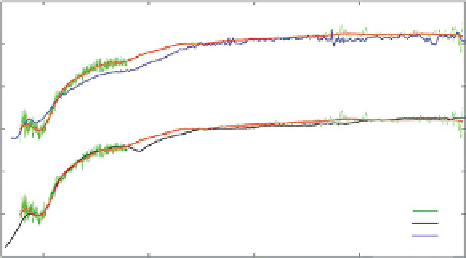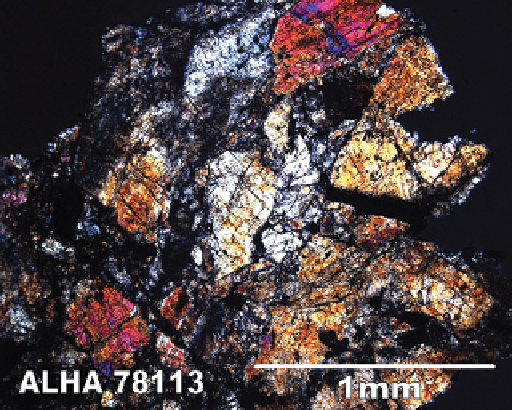Geology Reference
In-Depth Information
Aubrite
298.6 g
Found December 22, 1978
11.0 × 10.0 × 8.0 cm
Weathering = A/Be
oxygen isotopic value with Earth, Moon, and enstatite chondrites, and are
the most reduced basalts known. They contain unusual sulfides, low Feo
silicates, and sodic plagioclase feldspar. Some aubrites contain a basaltic
vitrophyre lithology that may represent a basaltic component from the
aubrite parent body. Their low Feo contents and small amount of metal
would give these samples a high albedo for a parent asteroid.
1. 4
1. 2
1
0.8
0.6
Average VNIR spectrum of Steins
0.4
57% Enstatite 42% Oldhamite 1% Orthopyroxene
Space-weathered aburite ALH-78113 Cs=0.18
0.2
0.5
1
1. 5
2
2.5
Wavelength (microns)
Plate 50
MiNERALogy
SigNiFiCANCE
ALH A78113 consists almost entirely of orthopyroxene
( Wo
0.6
En
99
) clasts up to 2 mm in a groundmass of commi-
nuted pyroxene. The pyroxene is an iron-free enstatite
(Feo < 0.1%) with minor and variable amounts of Cao
(0.2%-0.6%, average 0.5%). Accessory amounts of olivine
(Fo
99
), sulfides (troilite, and trace amounts of oldhamite,
alabandite, and daubreelite), and nickel-iron are present
as small grains in the groundmass.
ALH A78113 is the first Antarctic meteorite to be identi-
fied as an aubrite. it contains chondritic clasts and also
Feo-rich pyroxene, indicating that perhaps material from
another more oxidized parent body has become incorpo-
rated into aubrites. This meteorite has also been used to
compare to infrared spectra of E-type asteroids (left,
[378]) to determine possible parent bodies of enstatite
chondrites.
References [368-382]




